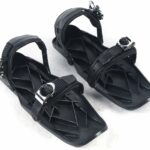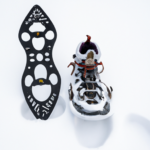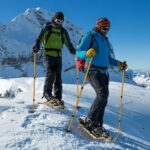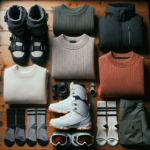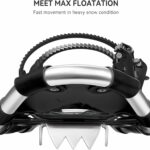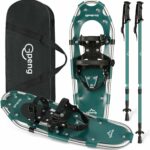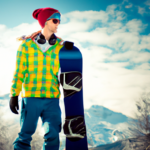So, you’ve invested in a pair of snowshoes for your frosty weather adventures, but now the question is: what shoes do you wear with them? In the article “What Shoes To Wear With Snowshoes?”, you’ll discover the perfect pairs that offer both warmth and comfort, no matter how deep the snow might get. You’ll gain insight into different types of footwear, the materials they’re made of, their insulation capacities, and, more importantly, how they match up with those trusty snowshoes of yours. We know it might be a bit puzzling, but don’t worry, this guide has you covered. So, tighten up your bootlaces and step into this engaging read.
Understanding Snowshoeing
If you’re a lover of the outdoors and enjoy the beauty of a winter wonderland, then snowshoeing might just be your next favorite winter sport! But what exactly is snowshoeing?
What is Snowshoeing?
Simply put, snowshoeing is walking in the snow with the aid of footwear designed specifically for this activity. These footwear, known as snowshoes, distribute your weight over a larger area, helping you walk without sinking too deeply into the snow. It’s one of the easiest winter sports you can take up – if you can walk, you can snowshoe!
Importance of Appropriate Footwear in Snowshoeing
When it comes to snowshoeing, the right kind of footwear is as essential as the snowshoes themselves. Cold, wet feet can quickly sap the joy from a snowshoeing trek. Moreover, wearing inappropriate footwear can lead to discomfort, blisters, and even potential injuries. That’s why understanding the types of shoes suitable for snowshoeing is crucial.
Types of Snowshoes
Several kinds of snowshoes cater to different activities, terrain, and snow conditions.
Recreational Snowshoes
These are the best for beginners and are designed for flat to mildly sloping terrain. They have user-friendly bindings and offer moderate traction.
Backcountry Snowshoes
Designed for steep, icy terrain, these are the sturdiest and most technical snowshoes. They offer robust bindings and aggressive crampons for maximum traction.
Running Snowshoes
These lightweight, small-sized snowshoes are built for speed and agility. They’re best suited for hard-packed snow and are usually used for winter races.
Parts of a Snowshoe
Understanding the anatomy of a snowshoe can improve your trekking efficiency and help you choose the right footwear.
Frame and Deck
The frame provides the structure of the snowshoe, while the deck – stretched across the frame – creates the surface that allows floatation on snow.
Bindings
Binding secure your boots to the snowshoes. They come in several variations which may affect the type of boots you need for snowshoeing.
Crampons and Traction Bars
These are located on the underside of snowshoes, providing grip and stability on icy or steep terrain.
Characteristics of Good Shoes for Snowshoeing
Now that you know about snowshoes let’s delve into what characterizes an excellent shoe for snowshoeing.
Insulation
Keeping your feet warm is crucial. Thermally insulated shoes ensure your feet stay toasty, even in below-freezing temperatures.
Waterproofing
Keeping your feet dry is as important as keeping them warm. Look for shoes with waterproof materials to prevent moisture from snow getting in.
Ankle Support
Snowshoeing often involves trekking over uneven surfaces. Shoes with good ankle support help prevent sprains or strains.
Sole Traction
Even though your snowshoes give a great deal of traction, the base boot should also have sturdy soles to provide additional security.
Best Types of Shoes to Wear with Snowshoes
Choosing the right type of footwear will largely depend on your particular needs and the snowshoeing activity you plan to engage in.
Insulated Winter Boots
These are the go-to option for recreational snowshoeing. They offer excellent insulation, waterproofing, and ankle support.
Hiking Boots
Hiking boots are usually waterproof and provide excellent traction. They’re great for backcountry snowshoeing.
Snow Boots
These boots typically have heavy insulation, profound waterproofing, and are great for colder conditions.
Running Shoes for Snowshoe Races
A pair of waterproof, insulated running shoes are perfect for snowshoe races. They offer speed, flexibility, and comfort.
Understanding the Fit between Shoes and Snowshoes
A proper fit between your shoes and snowshoes is crucial for comfort and safety.
Ensuring Correct Shoe Size
Your boots should fit comfortably – not too loose, and not too tight. Use your regular shoe size as a guide.
Checking Boot-to-Binding Compatibility
Ensure that your shoes fit securely into the snowshoe binding. Not all boots work well with all types of bindings, so it’s crucial to test this out.
Proper Fitting Techniques
To fit your boots into your snowshoes: loosen the bindings, fit your boot into the binding ensuring proper alignment, and then secure the binding straps.
Dressing for Snowshoeing
Now that you’ve got your footwear sorted, how about the rest of your outfit?
Importance of Layering
The key to staying warm but not overheating during physical exertion is layering. Layer your clothes so you can add or remove them as necessary.
Material Considerations
Go for moisture-wicking materials on your inner layer, insulating materials for your middle layer, and waterproof materials for your outer layer.
Managing Sweat and Moisture
Getting sweaty is unavoidable during a strenuous activity like snowshoeing. Ensure your clothing can wick away moisture to keep you dry and warm.
Maintaining Comfort During Snowshoeing
The more comfortable you are, the more enjoyable your snowshoeing adventure.
Adjusting Bindings
Ensure your bindings are adjusted to fit your boots securely, but not too tight that it restricts blood flow.
Dealing with Hotspots and Blisters
Prevent hotspots and blisters with good quality, well-fitting footwear. And always carry blister treatment kits just in case.
Foot Care Tips
Keep toenails short, wear good-quality, moisture-wicking socks, and let your feet rest during breaks.
Advice on Shopping for Snowshoeing Shoes
When shopping for snowshoeing shoes, there are a few things to bear in mind.
What to Look for in a Store
Ensure the store offers a good variety of insulated, waterproof footwear with solid ankle support and traction.
Trying On Shoes with Snowshoes
Whenever possible, try on shoes with snowshoes to make sure they fit comfortably together.
Useful Shoe Brands
Some popular brands known for quality boots for snowshoeing include Merrell, Columbia, and The North Face.
Conclusion: Importance of Correct Footwear in Snowshoeing
Recap on Shoe Types
Choose your footwear based on your snowshoeing activity, be it recreational snowshoeing, backcountry snowshoeing, or snowshoe racing.
Potential Consequences of Incorrect Footwear
Wearing improper footwear can lead to cold, wet feet, blisters, or even injuries. So, it’s crucial to get this aspect of your snowshoeing gear right!
In summary, finding the right shoes to wear with your snowshoes is vital for a comfortable, enjoyable, and safe snowshoeing experience. So, suit up, strap on those snowshoes, and get ready for a breathtaking walk in winter’s beauty!
- What Snowboard Bindings Should I Get? - January 23, 2024
- What Size Screws For Snowboard Bindings? - January 23, 2024
- How To Snowmobile On Water? - January 23, 2024

